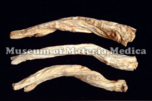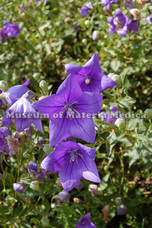Platycodon Root

|
Market name:桔梗 Photo location:Museum of Materia Medica, Inst. of Nat. Med. TMPW No.:4340 |

|
Plant name:Platycodon grandiflorum Photo location:Gansu Prov., China Photo date:2001 Photographer:K. Komatsu |
| Synonym | |
| Latin name | Platycodi Radix |
| Botanical source: Family name | Campanulaceae |
| Botanical source: Plant name | Platycodon grandiflorus A.De Candolle (IPNI:144523-1) |
| Part used | Dried root |
| Empirical criteria for quality selection | Good one has few branches, and the inside is white (TN). |
| Constituents | Polysaccharides: Inulin, Platycodinin Triterpenoids: Polygalacic acid, Platycodigenin, Platycogenic acid A, Platycogenic acid B, Platycogenic acid C, Platycodogenin Triterpenoid saponins: Platycodin A, Platycodin C, Platycodin D, Platycodin D2, Polygalacin D, Polygalacin D2 Sterols: α-Spinasterol, ⊿7-Stigmasterol, α-Spinasteryl-β-Dglucoside, Betulin |
| Pharmacological effects | Enhanced secretion of trachea, enhanced secretion of saliva, sedation, analgesia, expectorant, antiinflammatory, antiallergy. Inhibited secretion of gastric juices, antiulcer, peripheral vasodilation. |
| Indications | As an expectorant and antitussive, it is applied to treat cough and bronchitis. To discharge pus, it is applied to purulent disease, tonsillitis and sore throat. |
| Diseases | Cough, Impossible to expectorate sputum, Bronchitis, Pneumonia, Swelling and pain of the throat, Common cold, Nasal obstruction, Pituita, Hoarseness, Tonsillitis, Lung suppurations, Pyogenic dermatosis |
| Formulas | uyakujunkisan , en'nenhangeto , ogibekkoto , kagenryokakusan (asada) , kagenryokakusan (kyoteiken) , kakkoshokisan , karokijitsuto , kikyosekko , kikyoto , kyoseihatekigan , kyososan , kufugedokusan , keigairengyoto , keibohaidokusan , keimeisankabukuryo , gedaishimotsutokami , goshakusan , saikyohangeto , saikokikitsuto , saikoseikanto , sammotsuhakusan , shosaikotokakikyosekko , jijinmeimokuto , jumihaidokuto , jurokumiryukiin , jinsoin , jinryobyakujutsusan , seijobofuto , seihaito , senkanmeimokuto , senkin'naitakusan , takurishodokuin , chikujountanto , hainosan , hainosankyuto , hainoto , bofutsushosan , ryokakusan |
| Meridian tropism | Lung |
| Property | Neutral |
| Flavor | Bitter, Acrid/pungent |
| Classification in "Shen-non Ben-cao Jing" | Inferior |
| TCM: Classification | Expectrants and antitussives |
| TCM: Medicinal effects | To relieve cough, to soothe sore throat, and to promote expectoration and discharge of pus. Used for cough with much phlegm, oppressed feeling of the chest, sore throat, hoarseness of voice, lung abscess with purulent expectoration, abscess difficult to burst after suppuration. |
| Remarks | Listed in the Japanese Pharmacopoeia 18th ed. |
| References | TN: T. Namba & Y. Tsuda ed., Outline of Pharmacognosy, a Textbook, 3rd ed., Nankodo Co., Ltd., Tokyo, 1998. |
DNA sequences of medicinal plants
| Gene Region | |||||||||||||||||||
| Nuclear | Chloroplast | Mitochondria | |||||||||||||||||
| Botanical source: Plant name | 5Ss | 18S | ITS1 | 5.8S | ITS2 | 26S | others | trnH-psbA | matK | trnK | trnK-rps16 | trnT-L | trnL | trnL-F | rbcL | rpoC1 | ndhF | others | |
|
|
|||||||||||||||||||
